-
CENTRES
Progammes & Centres
Location
Bhutan realises that it can no longer afford to ignore its northern neighbour and aims to swiftly resolve its border issues through diplomatic negotiations
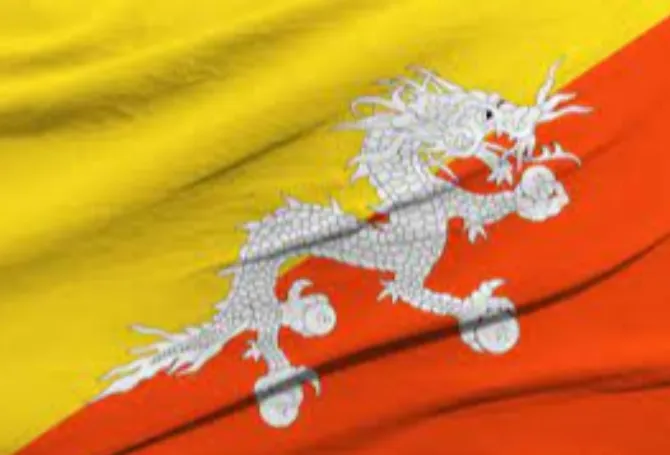
Bhutan and China held their 25th round of border negotiations on the 23rd and 24th of October, ending their seven-year-old impasse. The talks concluded with both countries signing a cooperation agreement to outline the functioning of the Joint Technical Team (JTT) on delimiting and demarcating boundaries. In addition, both parties expressed interest in ending the border dispute at the earliest and also exploring opportunities to establish diplomatic relations—a development that has been hinted at before by Bhutan's Prime Minister Dr Lotay Tshering on multiple occasions. Plagued by internal and external challenges like a weak economy, undemarcated borders, and no diplomatic relations with its northern neighbour—it appears that Bhutan can no longer afford to ignore a swiftly changing world order where an assertive and economically mighty China plays a crucial role.
Carrots and compellence
For most of the 20th century, Bhutan embraced isolationism from the rest of the world to preserve its unique culture and to avoid being dragged into great power politics. This was the case despite its Treaty of Friendship and Cooperation with India in 1949. Nehru’s visit to Bhutan in 1958 and China’s annexation of Tibet in 1959 finally convinced Thimphu to close its borders with its Northern neighbour and embrace a special relationship with India. While India’s assistance to Bhutan’s economy, development, and security has augmented with time, the latter has diversified its relationship with the rest of the world. Yet, it has continued to shy away from having diplomatic relations with the P-5 countries— China, France, Russia, the United Kingdom (UK), and the United States (US).
But unlike the rest of the P-5 countries, China and Bhutan have some unique problems. Bhutan, despite bordering China, has undemarcated borders and no diplomatic relations with the latter. This makes it the only neighboring country of China to have no diplomatic relations with Beijing and the second out of 14 countries (other than India) to have unresolved border disputes, thus, challenging Beijing’s status as a rising power and Asian hegemon. As a result, China has often used sticks and sometimes carrots to bring Bhutan to end the border dispute and establish diplomatic relations. It has continued to intimidate Bhutan by releasing new maps, encouraging border intrusions, weaponising Tibetan herdsmen to drive away Bhutanese grazers, and promoting settlements within Bhutanese territories. Incidentally, from 1984 to the Doklam standoff in 2017, Bhutan and China have had 24 rounds of negotiations.
In recent years, China’s rivalry with India, anticipation of a non-friendly Bhutan, and the potential unrest in Tibet have motivated Beijing to intensify the use of sticks against Thimphu. As a result, China has continued building new border villages in Bhutan’s disputed North and Western sectors and has made new claims in Bhutan’s Eastern sector. Bhutan has, in return, sped up its border dispute negotiations. For instance, in 2020, following the Galwan clashes—both Bhutan and China negotiated the three-step roadmap to demarcate borders on the table, visit demarcated lines, and formally demarcate the border. This Memorandum of Understanding (MoU) was signed in the 10th Expert Group Meetings (EGM) in 2021. Three subsequent EGMs—the 11th, 12th, and 13th meets took place in 2023 alone. On the sidelines of the 13th EGM, a Joint Technical Team (JTT) met to delimit the borders. Recently, both governments even held the 25th round of negotiations and signed a cooperation agreement to outline the functions and responsibilities of JTT. They also discussed the possibility of opening up diplomatic relations.
The complexity and stakes
With an intent to urgently resolve the dispute, Bhutan is ready to make uneasy compromises. Bhutan’s disputes with China are in the North, East, and West sectors. In the North, the disputed areas are Pasamlung and Jakarlung valleys (Map 1). Geographically speaking, this sector is considerably larger than the Western sector and is culturally crucial to Bhutan- yet it also holds very little geopolitical and strategic importance for China and India. As a result, China attempted to settle the dispute by unsuccessfully asking Bhutan to retain this region and cede the strategically crucial Western sector.
Map 1. Disputed regions in the Northern Sector
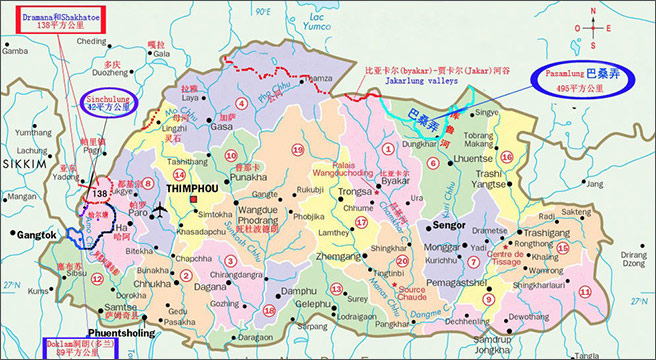
The Wire
In the East (Map 2), the Sakteng region stands disputed. This assertion was made only in 2020 and presumably originates from Beijing’s claim over Arunachal Pradesh. Nonetheless, the sector does not border China and has not been discussed in earlier negotiations.
Finally, in the Western sector, China and Bhutan dispute in Dramana and Shakhatoe, Sinchulungpa and the Langmarpo valley, Yak chu and Charithang valleys, and the Doklam region. These disputed regions are adjacent to China’s strategic Chumbi Valley—a narrow triangle between India and Bhutan. Going by its current claims (Map 2), China intends to broaden and deepen the triangle, which will enable it to improve its offensive positioning against India. On the other hand, India fears that an alteration might threaten its defensive position in the Siliguri corridor that connects the Northeast region with the rest of the country. It is here that the Doklam region gains prominence. Doklam is the only trijunction area of the sector where the borders of China, Bhutan, and India meet. Having control over this region offers China an in-depth presence in the Valley, and strengthens its surveillance capabilities across India’s Siliguri Corridor vis-á-vis the Jampheri Ridge. As a result, China asserts that the trijunction begins at Gipmochi, while India and Bhutan maintain Batang La as the trijunction (Map 2). China’s attempts to construct a road inside Doklam had even contributed to a standoff with India in 2017.
Map 2. Disputed regions of the Western and Eastern sectors
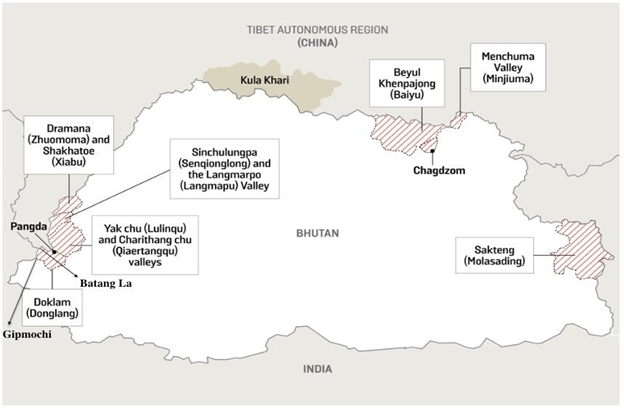
Source: Foreign Policy; Author’s additions
Given Bhutan’s security complexities involve an assertive China and a special relationship with India, Thimphu is ensuring that both parties are happy with the border negotiations. It has continued talking to China and hinted at ceding certain territories. Such negotiations might include territories in the East and North sectors, where Bhutan has consistently denied Chinese intrusions and settlements. Considerable changes could be expected in the Northern sector as it entails fewer complexities. In the West, Bhutan has admitted that negotiations over the Doklam region would be a trilateral issue—indicating the possibility of swapping other territories in the sector apart from Doklam. Nonetheless, ceding can also be expected around Doklam (such as Pangda village), considering Bhutan’s history of denial of Chinese incursions in the region. This agreement might also appease China since it offers a broader (if not an in-depth) presence in the Chumbi Valley. Finally, in the East, it is unlikely that the concessions will include the Sektang sector—as it would open a new theatre of threat for India and also legitimise China’s claims over Arunachal Pradesh.
Economic aspirations:
By demarcating the borders, Bhutan is also expecting to enhance its diplomatic and economic relations with Beijing. Today, Bhutan faces several economic issues like dwindling foreign reserves, increasing trade deficit, weak private sector, looming debts, growth fueled by public spending, slow recovery of tourism, revenue deficits, etc. Such economic issues have also triggered a youth exodus from the country. Thus, following the COVID-19 outbreak, there is a push for economic reforms and restructuring in the country. The government is keen on diversification, import substitution, promotion of exports, and focus on digital and IT and science and technology sectors. In addition, four industrial parks and a special economic zone are under progress in Bhutan and are expected to bring investments and promote economic growth. Bhutan has also shown interest in offering incentives to global companies that operate in India if they are willing to invest in the country. In fact, given the need for reforms, investments, and growth, it should not be a surprise that in recent years, Bhutan has vocally expressed the need to reap economic benefits from China.
Such aspirations have also coincided with increasing imports from China. While Bhutan’s expenditure on imports has amplified following the COVID outbreak due to high inflation, a boom in economic activities, and more disposable income, imports from China have been gradually growing in the last decade. In the previous two years alone—imports have increased exponentially from INR 2 billion in 2020 to INR 15 billion in 2022 (refer to Table and Graph 1). The nature of imported commodities includes imports of minerals/ chemicals such as coke, aluminum, calcium, rare earth metals, ferroalloys, etc.; capital goods of crucial sectors, such as agricultural machines, medical equipment/ machines, IT equipment, construction sector, etc.; durable and intermediary imports such as telephones, TV, fridges, textile, garments, furniture, tiles, windows, doors, prefabricated buildings, etc. This nature of imports of machinery and durables thus indicates that as Bhutan grows and restructures, China will continue to be a viable partner.
Table 1. Trade between Bhutan and China in Billion Ngultrum/ INR
|
Year |
Imports from China |
Exports to China |
Total Trade with China |
|
2006 |
0.28 |
(<) 0.0001 |
0.28 |
|
2007 |
0.4 |
0.019 |
0.41 |
|
2008 |
0.84 |
0.012 |
0.85 |
|
2009 |
0.48 |
0.0015 |
0.48 |
|
2010 |
0.61 |
(<) 0.0001 |
0.61 |
|
2011 |
0.87 |
0.006 |
0.87 |
|
2012 |
1.3 |
0.0024 |
1.3 |
|
2013 |
1 |
0.001 |
1 |
|
2014 |
0.94 |
0.004 |
0.94 |
|
2015 |
1.3 |
0.0019 |
1.3 |
|
2016 |
1.4 |
0.008 |
1.4 |
|
2017 |
1.6 |
0.0014 |
1.6 |
|
2018 |
1.6 |
0.0014 |
1.6 |
|
2019 |
1.7 |
0.005 |
1.7 |
|
2020 |
2 |
0.0011 |
2 |
|
2021 |
7.5 |
0.155 |
7.7 |
|
2022 |
15 |
(<) 0.002 |
15 |
Source: Ministry of Finance, Bhutan
Graph 1. Trade between Bhutan and China in Billion Ngultrum/ INR
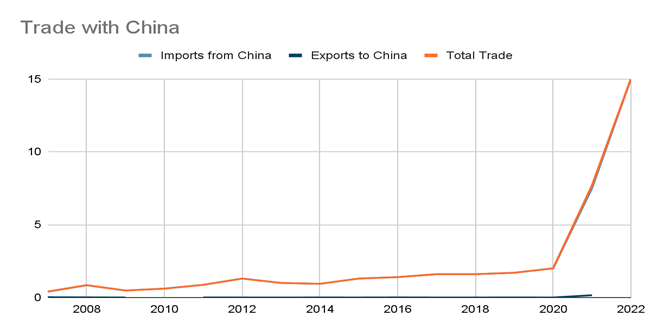
Table 2. Trade between Bhutan and India (without hydropower trade) in Billion Ngultrum/ INR
|
Year |
Imports from India |
Exports to India |
Total Trade with India |
|
2006 |
13 |
14 |
27 |
|
2007 |
15 |
22 |
37 |
|
2008 |
17 |
21 |
38 |
|
2009 |
19 |
12 |
31 |
|
2010 |
29 |
15 |
44 |
|
2011 |
35 |
15 |
50 |
|
2012 |
41 |
17 |
58 |
|
2013 |
43 |
17 |
60 |
|
2014 |
47 |
21 |
68 |
|
2015 |
53 |
19 |
72 |
|
2016 |
55 |
19 |
74 |
|
2017 |
53 |
19 |
72 |
|
2018 |
59 |
21 |
80 |
|
2019 |
56 |
23 |
79 |
|
2020 |
51 |
15 |
66 |
|
2021 |
71 |
26 |
97 |
|
2022 |
85 |
26 |
111 |
Graph 2. Trade between Bhutan and India (without hydropower trade) in Billion Ngultrum/ INR
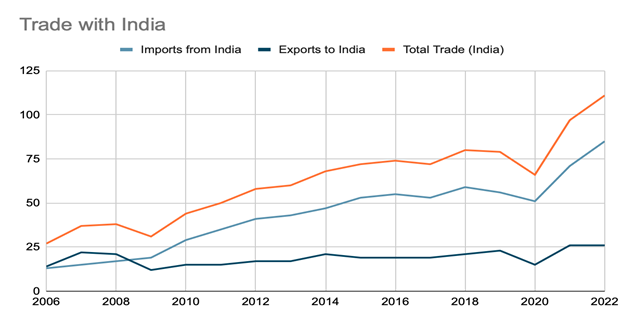
Source: Ministry of Finance, Bhutan
This trade with China is lesser in quantity and also one-sided when compared to India (see Table 2 and Graph 2). However, demand for Chinese goods has grown in recent years despite being imported through India, subjected to high prices, taxes, and unfair practices. In addition, China has continued to hint at further prospects of cooperation and trade concessions for Bhutan with the establishment of diplomatic relations. Incidentally, there is a justification on why Bhutan is calling for an economic and diplomatic relationship with China. Despite geographical and economic factors pushing Bhutan to look South for trade and security, China has now become an inalienable part of Thimphu’s strategic and economic calculations.
Aditya Gowdara Shivamurthy is an Associate Fellow with the Strategic Studies Programme at the Observer Research Foundation
The views expressed above belong to the author(s). ORF research and analyses now available on Telegram! Click here to access our curated content — blogs, longforms and interviews.

Aditya Gowdara Shivamurthy is an Associate Fellow with the Strategic Studies Programme’s Neighbourhood Studies Initiative. He focuses on strategic and security-related developments in the South Asian ...
Read More +